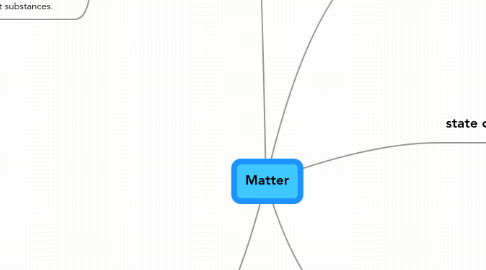
1. types
1.1. pure substance
1.1.1. elements
1.1.1.1. Contain only the one sort of atom.
1.1.1.1.1. atoms
1.1.1.2. periodic table
1.1.1.2.1. non metals -top right
1.1.1.2.2. metals -left side
1.1.1.2.3. element symbols -you must learn the ones you're supposed to know.
1.1.2. compounds
1.1.2.1. Made of different sorts of atoms that have joined in set numbers.
1.1.2.2. Hard to get back the different kinds of atoms.
1.2. mixtures
1.2.1. Contain more than one substance.
1.2.2. The different substances haven't joined up.
1.2.3. Easy to separate out the different substances.
1.2.3.1. filtration
1.2.3.1.1. Separating a liquid from a solid that's sitting in it.
1.2.3.2. decanting
1.2.3.2.1. Pouring something from off the top of another substance.
1.2.3.3. evaporation
1.2.3.3.1. Letting the water evaporate away from something that's dissolved in it.
1.2.3.4. distillation
1.2.3.4.1. Separating liquids with different boiling points.
1.2.3.5. centrifuging
1.2.3.5.1. Spinning something very fast-heavy particles thrown to the botton.
1.2.3.6. magnetism
1.2.3.6.1. Using a magnet to pick up iron from other stuff that's not magnetic.
2. liquids
2.1. solutions
2.1.1. When one thing dissolves in another.
2.1.1.1. solvent-does the dissolving.
2.1.1.2. solute-what dissolves.
2.1.1.3. saturated
2.1.1.3.1. No more solute will dissolve.
2.1.1.4. concentrated (strong)
2.1.1.4.1. Lots of solute and not much solvent.
2.1.1.5. dilute (weak)
2.1.1.5.1. Lots of solvent and not much solute.
2.2. suspensions
2.2.1. When something doesn't dissolves but just hangs there e.g.mud in water.
2.3. miscible (mixable)-when two liquids and mix in with each other e.g. meths and water
2.4. immiscible
2.4.1. Liquids that won't mix together e.g. oil and water.
3. states
3.1. solids
3.1.1. particles close together
3.1.1.1. Particles stay in one place and just vibrate-not much energy
3.2. liquids
3.2.1. Particles further apart.
3.2.1.1. Particles move quite a bit (randomly). They'll fill all the volume there is -more energy than solids.
3.3. gases
3.3.1. Particles a long way apart.
3.3.1.1. Particles move lots. They'll fill all the volume there is -lots of energy
4. state changes
4.1. melting
4.1.1. solid to liquid
4.2. evaporating
4.2.1. liquid to gas
4.3. boiling
4.3.1. liquid to gas but when most particles have enough energy to do it.
4.4. subliming
4.4.1. solid to gas (iodine does this and so does dry ice).
4.5. condensing
4.5.1. gas to liquid
4.6. freezing
4.6.1. liquid to solid
5. properties
5.1. Things that matter is or has.
5.1.1. colour
5.1.2. temperature
5.1.2.1. The average kinetic (movement) energy of the particles.
5.1.3. volume
5.1.3.1. How much space it takes up.
5.1.4. density
5.1.4.1. How many particles (mass) there are in a certain space.
5.1.5. melting point
5.1.5.1. At what temperature does it turn to a liquid.
5.1.6. boiling point
5.1.6.1. At what temperature does it turn to a gas.
5.1.7. conductivity
5.1.7.1. Is it a good conductor of heat or electricity?
